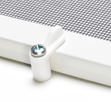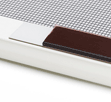Which mesh & fixings - com. HD framed window screens
Which mesh do I need ?
We offer three types of mesh with this screen. Your choice will depend on which insects you wish to keep out and the type of use. All three meshes are fully compliant with food safety regulations.
Standard insect mesh - 18 x 16 holes per square inch
Examples of insects this mesh will keep out: Bees & Wasps, Bluebottles, Cluster Flies, Crane Flies, Daddy-Long-Legs, House Flies, Hornets, Ladybirds, Mosquitoes, Moths, Butterflies and Spiders. Standard insect mesh is designed and manufactured to ensure maximum visibility (through the screen) ensuring as much light passes into the room as possible.
We recommend this mesh for all areas of the UK except in parts of Scotland where Midges are present and other parts of the UK where Corn Flies and Thunder Bugs/Thrips are present.
Midge mesh - 30 x 20 holes per square inch
This mesh will keep out: The same as Standard insect mesh + smaller insects such as Midges.
Midge mesh has a tighter weave than Standard insect mesh to ensure Midges, cannot penetrate, however, the visibility and airflow is reduced slightly.
We recommend this mesh in parts of Scotland where Midges are present and other parts of the UK where potentially smaller insects can be found.
if you are specifically looking to keep out Corn Flies and Thunder Bugs/Thrips please contact us as this requires a tight weave specialist mesh.
Please note - genuine Midge mesh is 30 x 20 - anything less e.g. 20 x 20 or 18 x 16 will not keep midges out.
Stainless steel insect mesh - 18 x 14 holes per square inch
Examples of insects this mesh will keep out: Bees & Wasps, Bluebottles, Cluster Flies, Crane Flies, Daddy-Long-Legs, House Flies, Hornets, Ladybirds, Mosquitoes, Moths, Butterflies and Spiders.
Stainless steel insect mesh is highly durable and long lasting which makes it ideal for demanding commercial environments.
We recommend this mesh for screens in commercial kitchens, where regular screen cleaning is required and routine use may result in damage to a standard mesh.
Fixings
The width of the screen frame that sits against your window frame is 39mm. It's not essential for the screen frame to fully overlap your window frame, but you should note that the hinge fixings and turn buttons sit to the side of the screen, so an allowance needs to be made for them. Please see dimensions below.
Lift on/off hinges with turn buttons
This fixing consists of a 2 part hinge, one part fixes to the edge of the screen and the other to your window frame. Both are screwed in position. The two hinge parts are connected with a pin which can be removed to allow you to lift the screen off the hinge for cleaning. The screen is held closed with turn buttons as shown in the second image below. The button is turned through 90 degrees to lock/release the screen. A handle is provided to assist with opening and closing the screen.
You will require 16mm of flat window frame space next to your screen to fit the hinges on one side and 10mm to fit the turn buttons on the other side.

Magnetic strips
No drilling or screwing is required for this magnetic option. It consists of two, self-adhesive magnetic strips, one adheres to your window frame, the other adheres to the back of the screen. As the strips are positioned within the width of the screen frame you don't need to make any additional allowance for this fitting but the screen frame will need to overlap your window frame by 22mm

Turn Buttons
The screen is held closed with 'turn buttons' screwed into your framework to the side of the screen. The button turns through 90 degrees to lock/release the screen. You will require 10mm of flat window frame around your screen to fit the turn buttons. If space is limited on some sides you could just fit to the sides or alternatively top & bottom.

